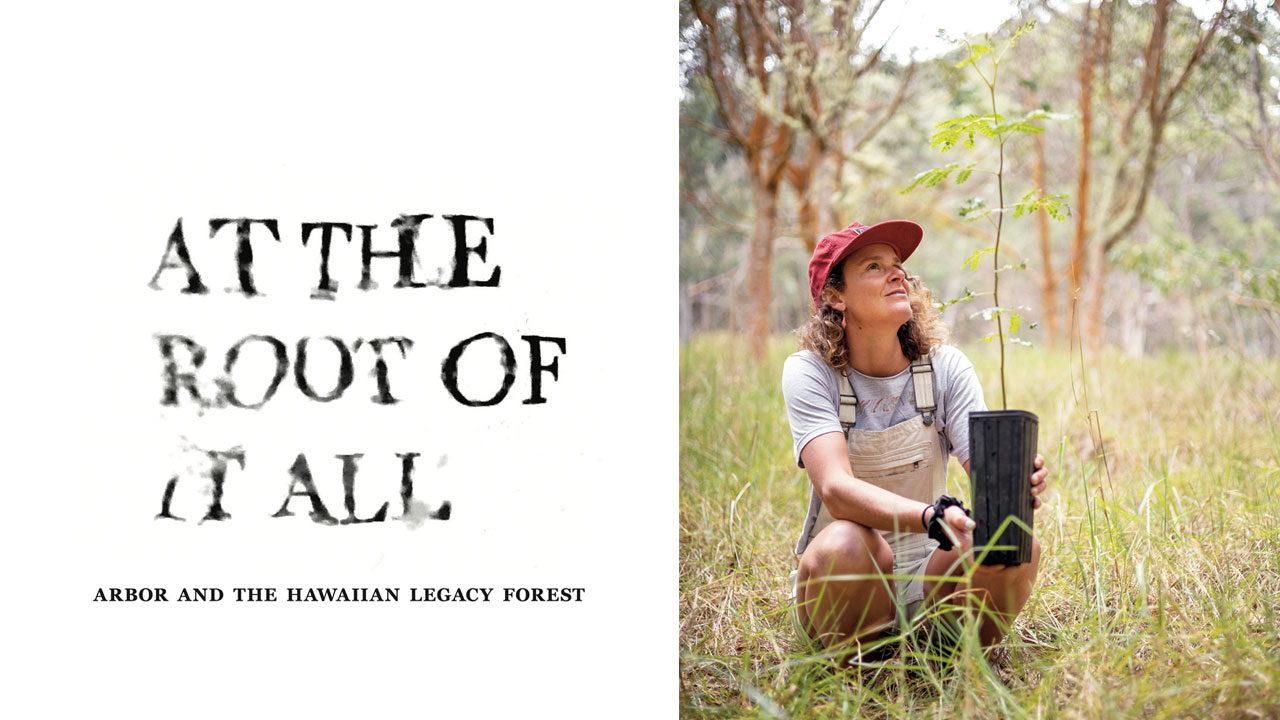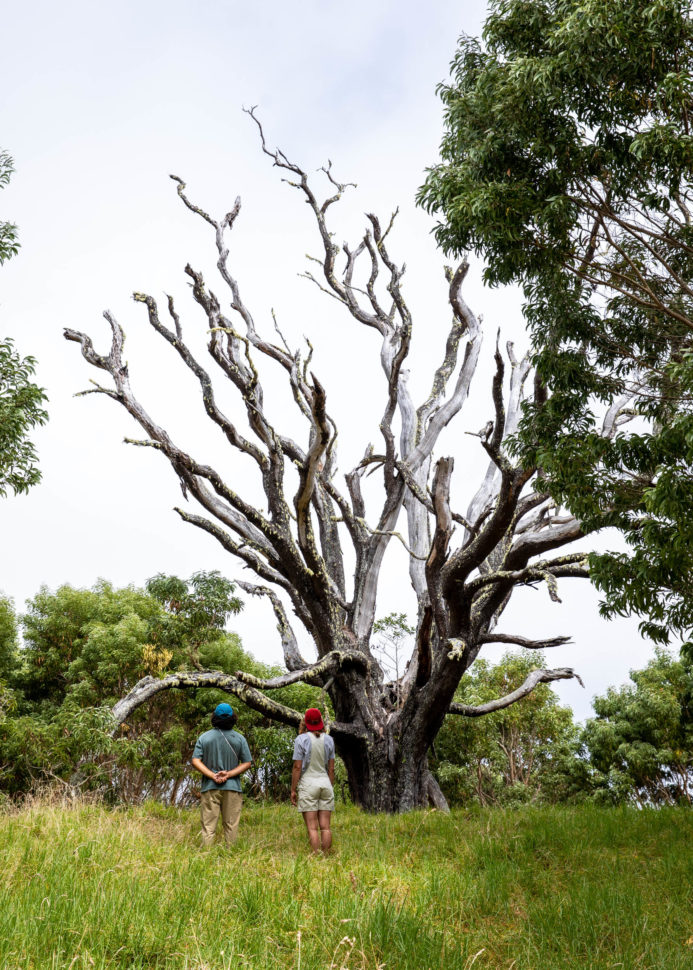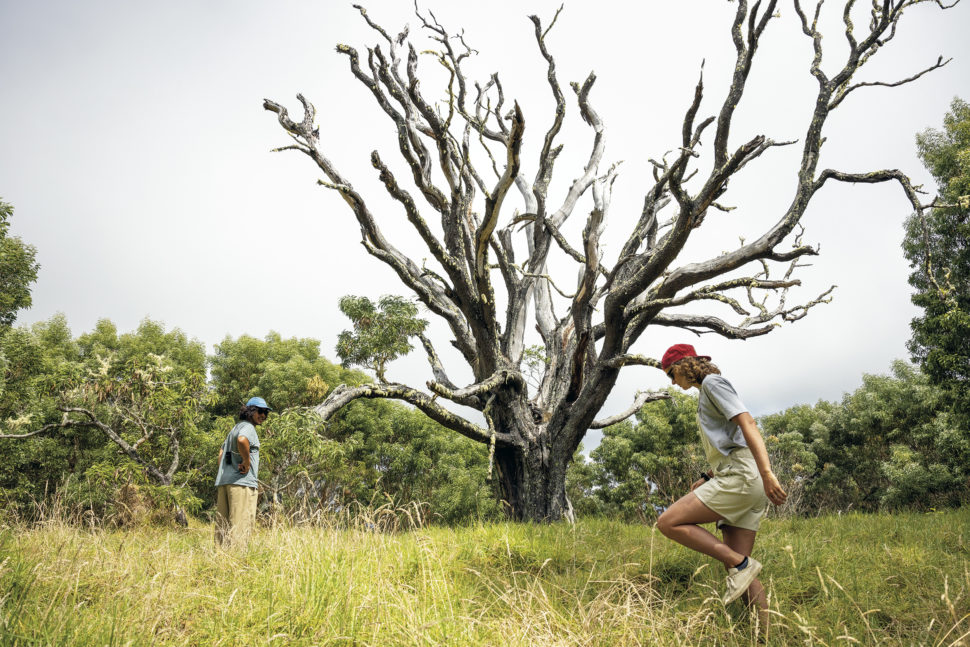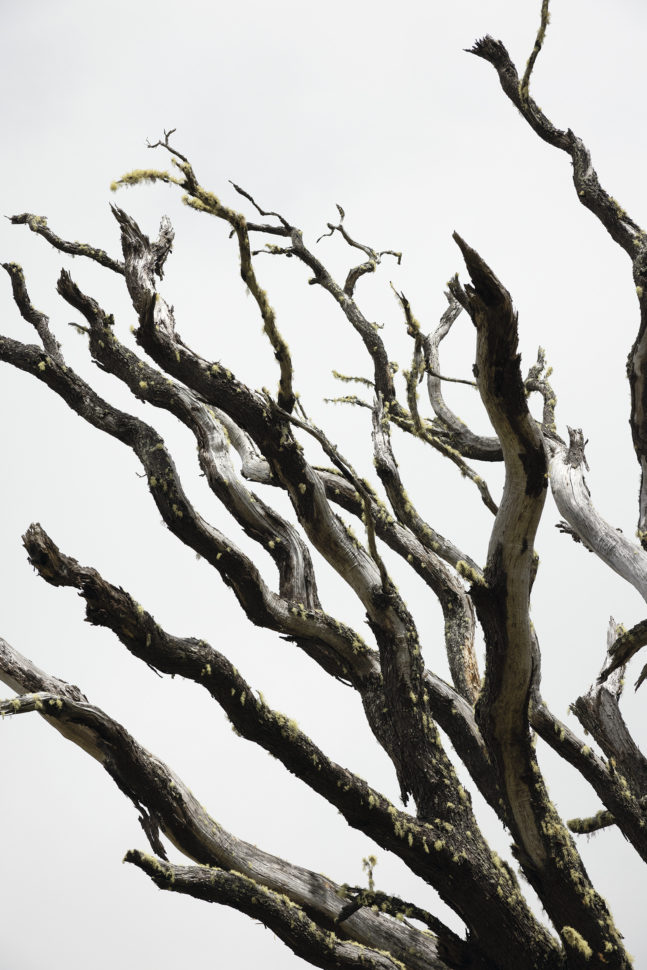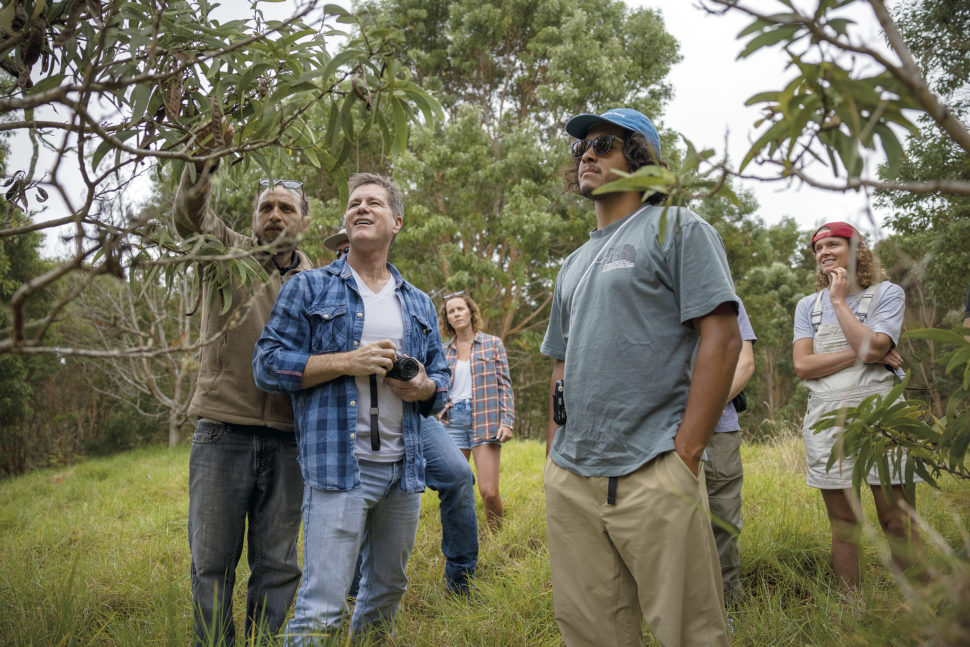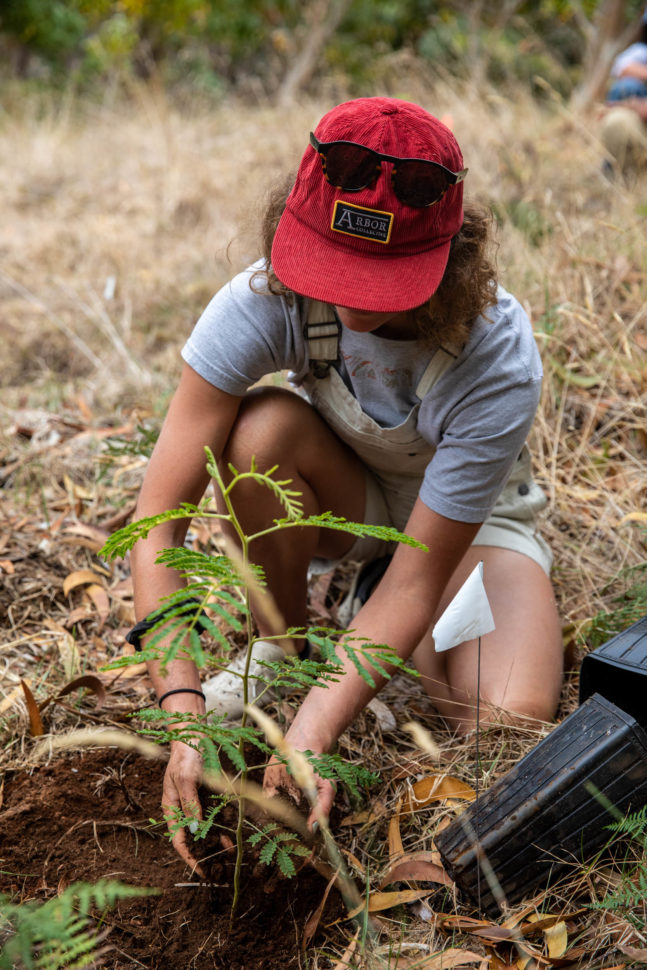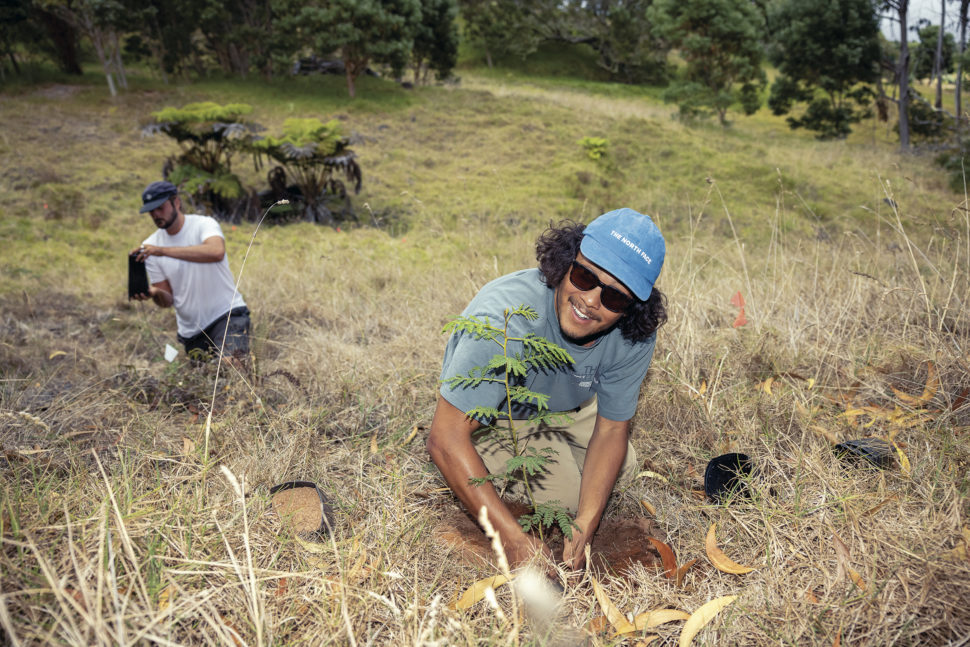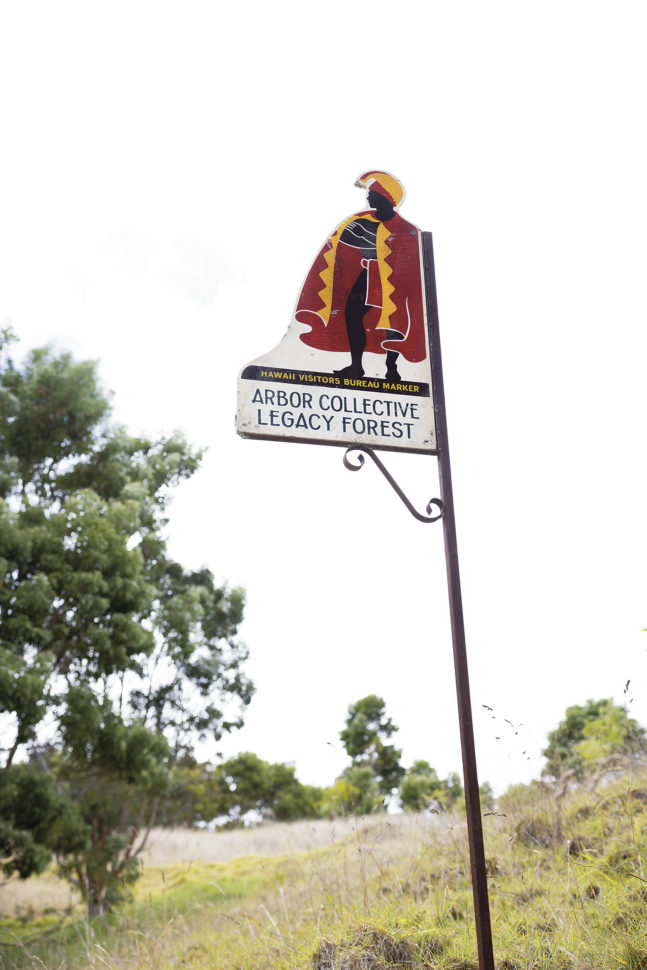Products You May Like
At the Root of It All: Arbor and the Hawaiian Legacy Forest.
IT WAS OVER 90 DEGREES WHEN I LANDED IN HAWAI’I, stepping off the plane into the open air of Ellison Onizuka Kona Airport. The ocean was a few hundred yards from the runway and parallel to the water, black lava rock stretched out as far as you could see in either direction. I walked no more than fifty feet from plane to passenger pick up, met up with Marie-France Roy, Erik Leon, Arbor Snowboards marketing director Dave Marx and sales director Scott Klamecki and hopped in a rental minivan. We’d made it. We were on a snowboard trip in Hawaii.
On the Big Island of Hawai’i, everything you encounter sparks a sense of wonder: the enormous stingrays; the plentiful lilikoi; warm, reef-filled oceanwater; towering lava rock cliffs; wildlife skittering between enormous plants; and of course, the overflowing and welcoming spirit of aloha. The island is otherworldly, especially when it’s your first time visiting. Time slows down and everything around you feels vibrantly alive, though the colors may be the most striking thing of all. Everything in Hawaii is bright. Incandescent aquamarine water. Deep green leaves. Pink, orange, and purple flowers. Dark red urchins and multicolored fish. Tiny lizards with lime green scales and bright blue feet that run up and down the corners of buildings. And so many different kinds of yellow fruit that weigh down branches and fill the baskets of roadside stands. It’s like the saturation has been turned all the way up, every Hawaiian hue almost palpable enough to feel.
This vivid spectrum is due to the Big Island’s wildly eclectic ecosystems. The island of Hawai’i has eight of the thirteen climate sub-zones in the world, making it one of the most ecologically diverse places on Earth. Our crew was staying on the outskirts of Kailua-Kona, a town of 23,000 people located on the west side of Hawai’i where dry steppe and humid tropical climates meet—black lava rock and underbrush punctuate a landscape that butts up to green-laden hills. Outside of Kona, the island’s topography transitions seamlessly from humid and tropical rainforest to arid desert and even polar tundra, each with its own cornucopia of plant and animal life. Environments that seem so disparate border one another; it’s wildly diverse, yet all interconnected.
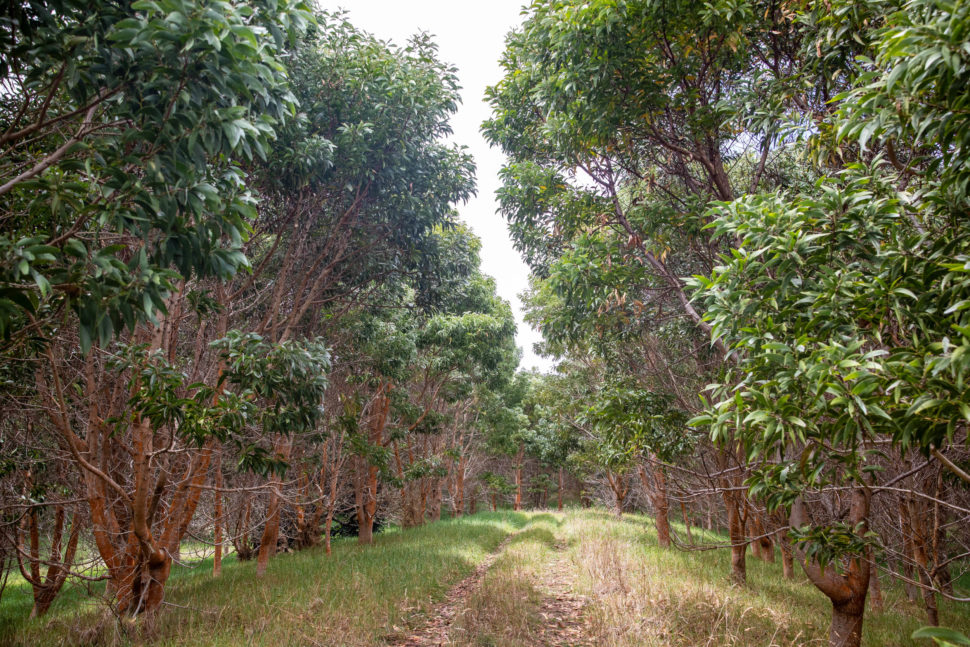
I had traveled to Hawai’i for a very special week with Arbor Snowboards. Once we arrived, we met up with Lucky Lopez and Mike Yoshida, and Arbor’s Julia Crouch, along with Pat Mahoney and Stu Langer from evo, and our crew was set. We were there because of snowboarding, which is a wild thing to get to say on a trip to Hawaii, but we weren’t doing any actual boarding. We were there because of Bob Carlson, Arbor Collective founder and CEO, and the ethos that he has instilled in his company. He founded Arbor in 1995 with the intention of keeping the environment at the forefront of crafting snowboards, and has been committed to sustainability in a very forward-thinking, yet achievable way since day one. Arbor’s Forest to Forest sustainability cycle is at the core of the company’s efforts, beginning with only using highly renewable and sustainably sourced wood from well-managed sources. During every step of production, the most responsible processes are used and continually re-evaluated and evolved as technology improves: Arbor’s factory is 100% solar powered and operates in a closed system that reuses all water and upcycles all wood bi-product; the brand’s iconic Powerply topsheets are used in place of non-biodegradable composites and reduce reliance on glues and coatings; plant-based resin takes the place of petroleum-based resin; and each snowboard is finished with sustainable components, including recycled steel edges and low-waste bases. The final step of the entire process brings things full circle through supporting the reforestation of indigenous trees—something that Arbor has been doing since the very beginning. This is where Hawaii comes in. Moving the needle ahead in both manufacturing processes and through giving back, Carlson has calcified the connection between Hawaii and snowboarding in a very special way.
We were going to the Hawaiian Legacy Forest, a 1,200-acre swath of land managed by the Hawaiian Legacy Reforestation Initiative that Arbor has been helping to reforest with Koa trees for the past seven years. Over that time, Arbor’s contributions have helped to plant over 560,000 native and endemic trees—a portion of each Arbor sale is donated to the reforestation efforts. Within the overall area, Arbor has a special Legacy Forest plot of its own, an acreage where the trees are protected in perpetuity. This is the fourth forest on Hawaii that Arbor has helped to rebuild, and unlike other programs where the purpose is to repopulate trees for lumber harvest, Arbor’s collaborations are driven 100% by ecological restoration. It’s not just simply planting trees; the process is helping to rebuild the complete biodiversity of an environment that may be seemingly far from the mountains, but in fact is inextricably linked through roots, intention, and ecological symbiosis.
The Hawaiian Legacy Forest is perched a few thousand feet above sea level in a region known as the Hāmākuma Coast on the northeast side of the island, in a temperate rainforest climate. Hundreds of years ago, Koa trees flourished in this area, but in the 1800s, the trees were cut down en masse to make way for sugarcane farms and cattle. With the loss of massive Koa forests that were native to the island came the elimination of whole ecosystems. The watershed suffered as Koa trees play an important role in collecting both precipitation and pollutants from the atmosphere. Rivers dried up and birds, animals, and insects disappeared. The Koa is also a nitrogen-fixing tree, which means the species is able to process nitrogen (a necessary ingredient for photosynthesis) to fertilize the soil, helping forest plant life as a whole. In short, as the Koa tree decreased in number, everything else in the habitat suffered, too. Then, in the early 1900s, Koa became a popular wood to build furniture, jewelry, and other exported products because of its unique color and grain, as well as its connection to Hawaiian culture. Harvesting the trees ramped up and soon, 90% of Hawai’i’s Koa population was gone.
IT TAKES ABOUT FORTY MINUTES to get from the Hawaiian Legacy Forest lodge into the Koa forest. Koa trees like to grow at higher elevations and this forest lives between 3,800 and 5,000 feet above sea level. The area is accessible only by off-road vehicle, in this case, a refurbished 6×6 Pinzgauer Austrian military vehicle from the 1960s that crawls and bounces over rugged paths, weaving through lower treed enclaves and kicking up dust in its wake. Our guides were Jeff Dunster, co-founder and executive director of the Hawaiian Legacy Reforestation Initiative, along with the non-profit’s staff members and Legacy Forest stewards, Dennis, Rich, and Kaitaya. Dennis drove the Pinzgauer and Jeff sat in the open-air back with us, explaining the history of the Legacy Forest and pointing out different species of plants. Jeff is a natural storyteller, affable and quick to make puns. Years ago, his affinity for Koa wood furniture alerted him to the dearth of the trees. “I realized I was part of the problem,” he says, “and I wanted to be part of the solution.” Through that simple idea, the Initiative was started and Jeff began working to create this forest with his partner, Darrell Fox. But logistically, it’s expensive to build a forest, something that the pair realized early on. So, they established as a non-profit and brought on brand partners to help their efforts, emphasizing relationships and dedication to sustainability. Arbor was one of the very first to come on board.
“Arbor comes out here every year and they go up that mountain, they get their hands in the dirt, and they plant trees,” says Jeff. “It isn’t just somebody writing a check so they can check a box for their environmental sustainability goals. It’s coming from the heart. We like working with people like that. We’ve been very fortunate that our partners are very committed to the project, not just for the optics, but for the heartfelt reasons for doing something.”
Eventually, we reached a sudden line of tall grass, a hallway of verdant green at just shy of 4,000 feet above the ocean that marked the beginning of the Legacy Forest. Until that point, we had been traveling through rows of ghost-like, barkless Eucalyptus—an invasive species whose oil is so acidic it kills everything around it. Now, suddenly everything was bright again. Sunlight drenched the green leaves and orange trunks of the Koa trees as far as we could see. We hung onto overhead metal bars to steady ourselves as we headed up hill in the Pinzgauer. We stopped to smell sandalwood flowers—another tree species that HLRI is working with—and eventually pulled up to a clearing with a single tree standing by itself. The Lone Koa.
Koa trees only grow in Hawaii, mainly on the Big Island, and efforts to introduce them to other areas of the world have been unsuccessful. A transplanted Koa may live a few years, but then it withers, too connected with its homeland to survive far away. Truly, the connection that the Koa have with Hawaii is deep. The trees lived on the island before man arrived and they’re cherished in Hawaiian culture. The first papa he’e nalu (surfboards) like the alaia, a round-nosed, square-tailed shape that dates back over 1,000 years, were made mainly from Koa by ancient Hawaiians, embedding the tree deeply in the foundation of surfing. It is because of this that Bob Carlson began contributing to Koa reforestation, honoring the very roots of boardsport culture. He created Arbor’s Returning Roots program—a thoughtful and impactful giveback to the planet. Each tree planted through Returning Roots not only benefits the environment and the ecosystem of Hawai’i, but is also a humble, yet meaningful reminder of the interconnectedness of it all. “This lies at the absolute root of everything we love,” Bob emphasizes. “It is really import to surf, skate, and snowboard culture, to Hawaiian culture, to that part of the planet and to the entire planet. That’s why we’re doing this. That’s why we’re there.”
Since Arbor began collaborating specifically with the Hawaiian Legacy Forest in 2015, the Venice, California-based brand has contributed to an enormously impactful ongoing effort. The Legacy Forest is home to some of Hawaii’s rarest birds, like the endangered ‘io (Hawaiian hawk) and the pueo (Hawaiian owl) who have returned to the area over the past decade. Riverbeds that have been dry are beginning to fill again. And the benefits extend far beyond the Big Island, of course, inextricably interconnected with the rest of the planet. When it comes to the overall impact on the world, Arbor has contributed 76.4 million dollars toward water recycling, 126.4 million toward pollution control, 63.7 million to soil erosion, and 63.7 million in oxygen production. “This is the massive impact of planting forests, not just trees,” says Carlson. And this is only from the past seven years, just part of Arbor’s continued commitment to giving back in significant and substantial ways.
HLRI also received the first gold standard carbon certification in the US and generates carbon offsets. All of this while they’re just about to meet their halfway goal en route to planting 1.3 million trees—one for every resident of Hawaii. The efforts have been so successful, that additional Legacy Forests are growing, one more on Hawai’i and three on Oahu (the newest forest project there began this fall), reforesting additional tree species and further benefitting the environment. For companies like Arbor that contribute to the efforts, the results are inspiring because as Jeff says, the goal is that “we want to leave a mark, but we don’t want to leave a scar.”
WHEN WE PULLED UP TO ARBOR’S LEGACY FOREST, Marie and Dave joyfully pointed out trees they had planted a year ago that were already over six-feet tall. The summer before, they had come out with Bryan Iguchi to plant Koa. This trip was Erik’s first. It was clear to see how much planting the trees meant to the entire Arbor crew—not only the experience, itself, but to be a part of a brand whose mission is bigger than just making snowboards. At the heart of Returning Roots and at the core of Arbor as a brand—because of the people who make it what it is—is the drive to contribute to something bigger, to share something that begins with snowboarding, but branches out into community, to the environment, and that grows in impact.
Fifty seedlings were gathered together under the canopy of their older siblings and as we marveled at the lichen that covers the Koa’s trunks and gives them their orange color, Rich watered the baby trees to prepare them for planting. We spread out on a hillside, encircling the area in which we were about to plant baby Koa, and Kaitaya said a Hawaiian blessing. Then we got our hands dirty, carefully putting the young trees in the ground and packing the nutrient-rich soil tightly around them before covering the ground around the planting with mulch. Each act on its own was small, a personal-sized piece of the puzzle of giving back to the earth. It’s easy to forget about our impact on the planet as we go about our days and weeks. We drive, fly, use lots of energy, and try our best to recycle and reduce our footprint, but the tangible effects can often be hard to see—even when the worst examples are displayed on repeat on the news. But holding these 12-inch-tall trees and placing them into the ground felt concrete. It felt like we were doing something for Mother Nature that was very small, but also very big. Each Koa we planted was a part of something larger than ourselves.
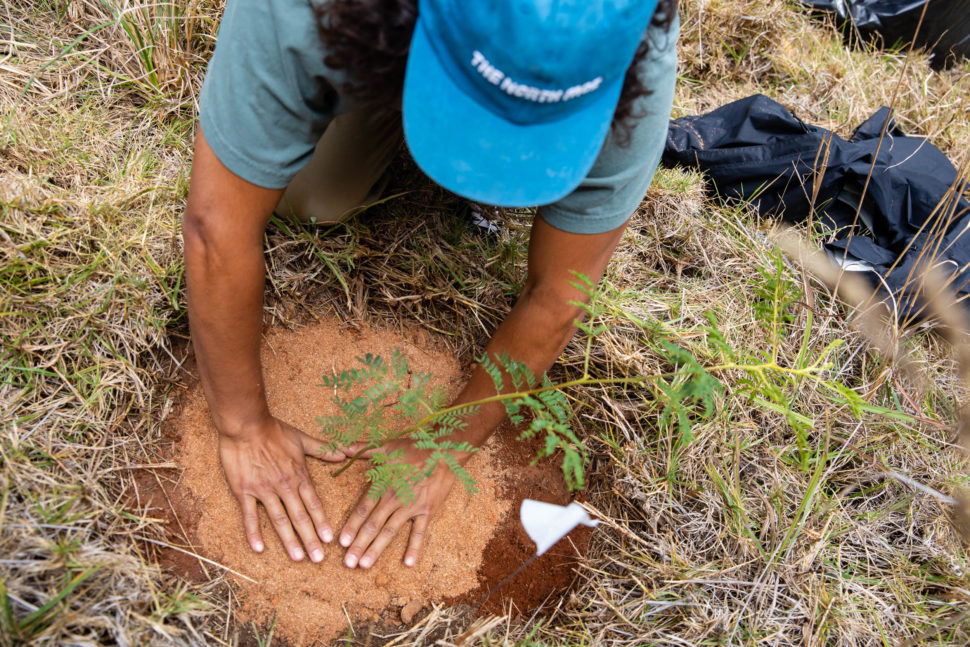
“The Arbor plot is about the total restoration of the original environment, with an effort to bring back the complete biodiversity of what once existed,” explains Bob. You can hear how important this to him, his company, and the company’s mission with each word he says. “That is what Legacy Trees are all about. It’s really meaningful for Arbor that we’re not just planting trees, we’re restoring complete forest.”
One of the special things that the Hawaiian Legacy Forest offers is the opportunity to dedicate a tree to a loved one or cause that you care about. In person, a quiet ceremony is performed, pouring water through cupped hands over the sapling in honor of the dedication. It’s a moment to slow down and appreciate the beauty of the process. While magical when in the forest, you can also do this on their HLF website if you can’t yet make it to Hawai’i. A modest donation plants a Koa tree, with the funds going toward operation of the HLRI to plant and protect the trees from invasive species, as well as an additional donation to a benefactor of your choice. An RFID tag is also added to each tree so you can track it on the Legacy Forest website and watch it grow. Through thousands and thousands of individual trees planted and dedicated, along with the work of the company partners, the Legacy Forest is thriving on the slopes of Mauna Kea. The HLRI has a lease on the land for the next fifty years, by which time they hope to have re-enlivened a once devastated environ, and by their success so far, things are looking really good.
BUT BACK TO THE LONE KOA. In 2010, when Jeff and Darrell first arrived at what would become the Legacy Forest, there was just a single Koa tree, standing by itself. No one can be sure, but at the time, they estimated it was about 70 years old. Jeff and Darrell began planting. At first, they lived in a tent and planted the trees by hand with a shovel. (Now they use special handheld tools to dig holes for new saplings more efficiently and they’ve got a crew to help.) Little by little, the forest grew. It’s been twelve years and by this winter, the Lone Koa will have over 600,000 family members. But in tribute to the mother tree, Jeff and crew have given her space to breathe, leaving an open thicket around the Lone Koa so she can stretch her branches high above her kingdom. They call her the Mother Koa now, no longer alone.
When we first reached the forest, we stopped on our way to Arbor’s plot of land and walked over to the mother tree, placing our hands against its massive trunk and staring up toward its highest limbs. All around the edge of the thicket, young Koas glowed bright orange and green; in less than ten years they were already two-plus stories high. Sadly, the Mother Koa’s life is nearing its end. She’s around 80 years old, her leaves have fallen, and her bark is gray. But she’s still the matriarch of the forest, her boughs twisting up toward the sky, a solitary reminder of what could have been but instead, surrounded by her fledgling Koa, is changing for the better.
To learn more about the Hawaiian Legacy Reforestation Initiative and Arbor’s work with the non-profit, as well as to contribute and plant your own Koa tree, check out www.legacyforest.org.
